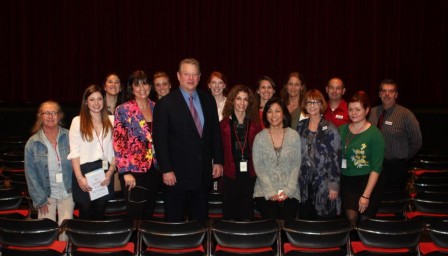Between the Lines: The Future is Now

Former Vice President Al Gore is with members of the Warwick’s crew and San Diego Law Library staff.
Warwick’s Books has done it again. Last fall they brought the author of one of my favorite contemporary novels to town (Amor Towles, “Rules of Civility”); in January they hosted Supreme Court Justice Sonia Sotomayor for a discussion and reading from her book “My Beloved World.” Most recently, a capacity crowd at UCSD’s Mandeville Auditorium heard Al Gore speak on his newest book, “The Future: Six Drivers of Global Change.” The February 10th event was co-presented by Warwick’s and the San Diego Law Library
The former vice president sketched an overview of “The Future”: a sweeping assessment of the state of the planet, what’s in store—for better and for worse—and what needs to happen to brighten an otherwise gloomy forecast. He was passionate and eloquent as he explained why this is a time of revolutionary change with no precedent in history.
The book is a weighty tome that includes more than 140 pages of notes to document its facts and findings. I confess to having made my way through only the introduction so far, but that’s enough to convince me that it’s well-researched, well-written, and comprehensive, drawing from history, philosophy, political science, economics, and numerous branches of science from genomics to geology.
What grabbed me first are the mind maps that precede each chapter. I’m mesmerized by these complex diagrams that incorporate historical and current events, reflections and ideas from every relevant discipline. Gore tells how, over a number of years, he built an outline, with headings and subheadings and categories, which he would rank and shift and augment as he developed his case. That outline is the extensive series of maps that appear as intricate webs threading through each chapter.
In his introduction, Gore states his dominant theme, that “what we do in the present, when informed by knowledge of the past, can shape the future in objectively better ways.” He goes on to identify the forces that are reshaping our world:
1) What he calls “Earth Inc.,” the ever-increasing economic globalization, with new and different relationships to capital, labor, consumer markets, and national governments.
2) As you would expect: technology—the computer revolution and worldwide digital communications that have led to the emergence of “the Global Mind” and all its implications.
3) A shifting of the balance of global political, economic, and military power to a system with multiple emerging centers of power, with China overtaking the U.S. as the center of gravity in the global economy.
4) An economic compass that leads to unsustainable consumption and depletion of strategic resources. One example he gives is the practice of making economic decisions that favor growth. What is meant by growth and progress, he asks? “If the impact of pollution is systematically removed from the measurement of what we call ‘progress,’ then we start to ignore it and should not be surprised when much of our progress is accompanied by lots of pollution.”
5) Scientific revolutions in genomic, biotechnology, neuroscience, and life sciences that are putting control of evolution in human hands. Gore titles this section “The Reinvention of Life and Death.” I counted 152 threads in the web/map that precedes this chapter, among them Frankenstein and Faust, genetic screening, three-parent babies and spider-goats.
6) And finally, what we expect from the man who brought us “Earth in the Balance and An Inconvenient Truth,” what Gore sees as a radical disruption of the relationship between human beings and the earth’s ecosystems; in other words, climate change. Hurricanes and floods and droughts, oh my!
Along the way and in his conclusion, he sets forth the kinds of choices that will have to be made to avoid the path that leads toward destruction, depletion and degradation in favor of the path the leads to the future. It’s a lot to think about. But first I have to read the book.
Category: Education, Local News







